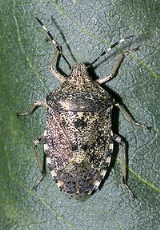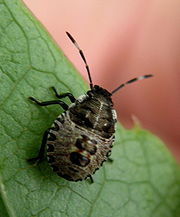
Rhaphigaster nebulosa
Encyclopedia
Rhaphigaster nebulosa is a Europe
an stink bug in the family Pentatomidae
.
.
stage. To protect against predators, young bugs have stink glands on their back; in the case of adults, these are to be found on the underside of the thorax
. If threatened, a strong-smelling secretion is released. They are not good fliers; their sluggish flight makes loud humming noises.
This species displays diurnal, thermophilic activity. As with most Pentatomidae, it produces only one generation per year. It likes to overwinter on walls covered with ivy
. In its search for suitable winter quarters (splits and cracks) it often unwittingly finds its way into houses.
This species produces a plethora of eggs when disturbed in its habitat. Angering or threatening the bug makes it produce an off-white colored secretion that can be harmful if swallowed. Chemicals in the secretion allow the eggs to continue to fertilize in any environment, even those that are highly acidic or basic. To prevent these excretions, this bug should not be killed by any means.
 This species is distributed throughout the Palearctic
This species is distributed throughout the Palearctic
region, more commonly in the southern than in the northern parts of Central Europe
, and is not known to occur in the United States
.
Europe
Europe is, by convention, one of the world's seven continents. Comprising the westernmost peninsula of Eurasia, Europe is generally 'divided' from Asia to its east by the watershed divides of the Ural and Caucasus Mountains, the Ural River, the Caspian and Black Seas, and the waterways connecting...
an stink bug in the family Pentatomidae
Pentatomidae
Pentatomidae, Greek pente meaning five and tomos meaning section, is a family of insects belonging to order hemiptera that includes some of the stink bugs and shield bugs. Their antennae are 5-segmented, which gives the family its scientific name. Their bodies are usually shield-shaped...
.
Description
This species reaches a length of 14 to 16 millimetres. It is coloured dirty yellowish-grey to brown with irregularly-distributed fovea on the top side of its body. The membrane of the forewings is often speckled dark brown. The lateral edge (Connexivum) of the abdomen has black and yellow markings. The antennae are ringed with black and yellow markings, and the third and fifth segments of the feelers are coloured a bright yellow. On its underside, between the hips, there is a long spur. The mouth parts are in the form of a proboscisProboscis
A proboscis is an elongated appendage from the head of an animal, either a vertebrate or an invertebrate. In simpler terms, a proboscis is the straw-like mouth found in several varieties of species.-Etymology:...
.
Biology
The bug feeds on various broadleaved woody plants. Occasionally it sucks on dead insects. In late spring, the female sticks around 40 eggs in lines or discs on different parts of plants. The young that hatch vary in colour and are flightless. Wing stumps are only recognisable after the third nymphNymph (biology)
In biology, a nymph is the immature form of some invertebrates, particularly insects, which undergoes gradual metamorphosis before reaching its adult stage. Unlike a typical larva, a nymph's overall form already resembles that of the adult. In addition, while a nymph moults it never enters a...
stage. To protect against predators, young bugs have stink glands on their back; in the case of adults, these are to be found on the underside of the thorax
Thorax
The thorax is a division of an animal's body that lies between the head and the abdomen.-In tetrapods:...
. If threatened, a strong-smelling secretion is released. They are not good fliers; their sluggish flight makes loud humming noises.
This species displays diurnal, thermophilic activity. As with most Pentatomidae, it produces only one generation per year. It likes to overwinter on walls covered with ivy
Ivy
Ivy, plural ivies is a genus of 12–15 species of evergreen climbing or ground-creeping woody plants in the family Araliaceae, native to western, central and southern Europe, Macaronesia, northwestern Africa and across central-southern Asia east to Japan and Taiwan.-Description:On level ground they...
. In its search for suitable winter quarters (splits and cracks) it often unwittingly finds its way into houses.
This species produces a plethora of eggs when disturbed in its habitat. Angering or threatening the bug makes it produce an off-white colored secretion that can be harmful if swallowed. Chemicals in the secretion allow the eggs to continue to fertilize in any environment, even those that are highly acidic or basic. To prevent these excretions, this bug should not be killed by any means.
Distribution

Palearctic
The Palearctic or Palaearctic is one of the eight ecozones dividing the Earth's surface.Physically, the Palearctic is the largest ecozone...
region, more commonly in the southern than in the northern parts of Central Europe
Europe
Europe is, by convention, one of the world's seven continents. Comprising the westernmost peninsula of Eurasia, Europe is generally 'divided' from Asia to its east by the watershed divides of the Ural and Caucasus Mountains, the Ural River, the Caspian and Black Seas, and the waterways connecting...
, and is not known to occur in the United States
United States
The United States of America is a federal constitutional republic comprising fifty states and a federal district...
.

